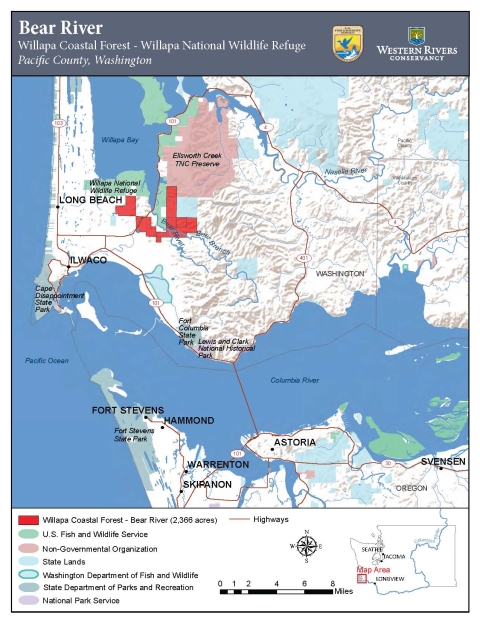At Willapa National Wildlife Refuge, tides ebb and flow through tidal creeks of the salt marsh salt marsh
Salt marshes are found in tidal areas near the coast, where freshwater mixes with saltwater.
Learn more about salt marsh that meet up with cool and cloudy maritime forest. These tidal creeks and channels were once dominated by Chum salmon, traveling miles upstream to spawn each fall. Historically, Willapa Bay had over 14,000 acres of saltmarsh, mudflats, and salmon-bearing streams. Less than half of these habitats remain in the bay due to changes in land management, construction of levees, and unsustainable fish harvest throughout the 20th century dramatically reduced the habitat and fish populations. But hope was not lost, a vast restoration the refuge started in 2012, restored nearly 500 acres of the Bear River estuary including the entire southern shoreline of the bay. By 2018 restoration was complete, bringing ecological and economic benefits to this part of Southwest Washington.
Today the Bear River estuary sees additional conservation and restoration on the horizon. Another partnership, eager to conserve lands within the watershed, led to a 2,366-acre expansion of Willapa National Wildlife Refuge for the benefit of fish, wildlife, and people. These lands, part of what is called the “Willapa Coastal Forest,” are located above the southernmost end of Willapa Bay flanking both sides of Highway 101 between Naselle and Ilwaco. They include 39 miles of streams, 210 acres of riparian riparian
Definition of riparian habitat or riparian areas.
Learn more about riparian area, 202 acres of wetland and 1,954 acres of coastal forest. This diversity of habitat benefits a suite of wildlife from the smallest of birds to the largest of mammals found in northwest coastal forests. But the biggest winners are anadromous fish including chum, Chinook, and coho salmon; steelhead and coastal cutthroat trout; and Pacific lamprey.
This addition to the refuge is the culmination of years of locally and regionally led efforts by the U.S. Fish and Wildlife Service (Service) and partners who are dedicated to conserving salmon habitat in the Bear River watershed. The effort was kickstarted in 2020 by Western Rivers Conservancy which set out to buy the lands from Forest Investments Associates. Funding for the acquisition came from Washington state’s Salmon Recovery Funding Board and the Land and Water Conservation Fund. At no cost to taxpayers, the Land and Water Conservation Fund is a federal program providing funds and matching grants to federal, state, and local organizations in support of projects that increase public access to and protection for federal public lands and waters. Once funding was secured, Western Rivers Conservancy purchased the property and conveyed it to the Service to become part of the Willapa National Wildlife Refuge.
Formerly, these forests were managed from an industrial model that maximized timber harvest. Now under refuge management, goals for the habitat will shift towards conservation, restoring self-sustaining, natural, ecological processes for healthy forests and streams. Habitat conservation in this way is essential to increasing the Refuge’s resiliency to future impacts due to climate change climate change
Climate change includes both global warming driven by human-induced emissions of greenhouse gases and the resulting large-scale shifts in weather patterns. Though there have been previous periods of climatic change, since the mid-20th century humans have had an unprecedented impact on Earth's climate system and caused change on a global scale.
Learn more about climate change . These actions will also benefit the threatened marbled murrelet, other migratory birds, and wildlife that depend on streams and forest. This property contains the lowermost reaches of Bear River, including the last unprotected portion of the estuary above the refuge boundary. This vital salmon-bearing stream will be managed to restore and retain robust populations of anadromous
fish including the once abundant chum salmon. As always, restoration and management under the Service will be based upon the best science available and may include restoration of forests, decommissioning of roads, improvements to streams, and removal of invasive plants.
Wildlife refuges are for people too and future public access will come with many opportunities for outdoor recreation including hiking, wildlife watching, big game hunting, environmental education, and interpretation. Because the process to open refuge lands to visitation takes time; access will be available in the coming years. As the Service conducts surveys and determines future management actions and recreational opportunities on these and other recently acquired lands it will seek public input to inform development of the final plans. Check back for updates on the progress of this exciting new addition to Willapa National Wildlife Refuge.




